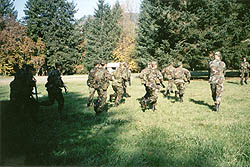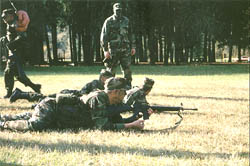
 |
||||
|
|
||||
ROTC's life on campus"The matter of military training in any school
|
||||||||
 |
ROTC students from the 2000-2001 class run up through the grass during a field exercise near Cottage Grove. |
Lt. Col. Bill Page still remembers driving down the campus streets in his army green military attire a decade ago.
"People were yelling at me because I was in uniform," said Page, who has been in the military for more than 20 years and was once a teacher for the University's Reserve Officers Training Corps. "Back then, the attitude of the school was that we were the enemy."
But now, he said, things have changed.
ROTC "students are much more accepted by the general campus community," he said. "That's one of the most significant changes."
From being mandatory to voluntary during different times in its history at the University of Oregon, the ROTC has stirred controversy among the campus community in its 85 years on campus. The Vietnam era brought the most debate, while the Gulf War and recent terrorism attacks made the program more accepted. But ROTC leaders say its mission to offer young men and women civic experiences has remained the same.
How the ROTC came to the University
The training program was brought to campus shortly after the passage of the National Defense Act, which established the ROTC in 1916. The University of Oregon president at that time, Prince Lucien Campbell, supported the campaign along with many other university presidents nationwide.
"The matter of military training in any school seems to me to be a training for better citizenship, rather than for war," he said on Jan 25, 1916, in the Oregon Daily Emerald. "The spirit should be civic rather than military."
For the first five decades, ROTC participation was mandatory for freshmen and sophomore males at all land-grant colleges.
 |
A junior ROTC student practices shooting and throwing grenades during a field exercise. |
Controversy
During the Vietnam era, however, the ROTC ignited heated debate at colleges nationwide. Anti-ROTC demonstrations became a common scene on campuses, and acts of vandalism, arson and violence were committed against ROTC leaders and facilities.
Concerns with the war's morality and cost ignited much debate at the University, and hundreds of letters protesting the ROTC requirement were published in the Emerald between 1961 and 1962.
The violent threats also reached campus. In 1962, a fire-bomb was planted in the University's military science building, causing more than $20,000 in damage.
"I can still remember students and faculty voting us off of campus," Page
said about the reaction to ROTC even years after Vietnam.
The ROTC became voluntary in 1962.
From the Gulf War to Sept.11
Page, who taught at the University between 1990 and 1993, left campus for several years. He said upon returning earlier this year, he sees a more "accepting" attitude toward the program.
This switch of direction is the result of a couple of things, he said. "Because of the Gulf War, people appreciated the military more, as they normally do in times of crisis, like now," he said.
He added that the program has become more visible. The ROTC building was once hidden behind the EMU, he said. But it has now moved now out on to Agate Street, and ROTC students have made greater attempts to talk to students and faculty about what the program is and what it incorporates.
Major Mark Chapelle, director of the military science department, agreed that people need to have more exposure to the program.
"There's a lot of misconception about ROTC and military science," he said. "A young girl called me the other day. She was in high school and was interested in joining the military. She asked, 'Do I have to cut all my hair off?'"
He added that even greater than the small questions such as these, many people wrongly assume that all ROTC students intend to fight in war someday or strive to become an officer of a higher ranking. Although the University's ROTC has produced 43 generals, which is more than any other non-military school, many students take part in the program for other reasons, he said.
"Some people just participate for fun and experience," he said. "Others intend to stay on for a job upon graduation."
Aside from military classes, ROTC students also participate in field exercises that include the physical aspects of military training. Dressed in uniform and covered in what they call "war paint," the group of 122 students practice grenade throws, ground crawls and war drills in army fields.
Senior Marcella Marchesano joined the ROTC a few years ago. As a child, she remembers seeing other reserves walking around in uniform in the streets of her hometown in California. She’s had an interest in the military ever since.
Now the ROTC's outreach director, Marchesano said actually participating in some of the exercises does create a more real sense of war for some students. One of the activities for example, involves searching the "dead" enemy for beneficial materials such as maps.
"I'm sure there are people who are like, 'Wow, I might actually have to do this someday,'" she said. "And if we reach our objective, somebody might get hurt; it's the reality of war."
Although she would not specifically comment on the possibility of Sept.11 causing a war that would need reserves, she said being in a leadership position has taught her that she cannot be scared.
"Scared is the wrong word," she said. "It makes it real that this is what you have to do. But we can't be scared as leaders, it's not our place. If we're scared, then what are our troops going to do?"
Freshman Bart Brink joined the ROTC this year before Sept.11. He said the attacks don't make him have any regrets about his decision.
"The attack hasn't changed my attitude at all," he said. "If anything it's made other people realize what we do and how important it is."